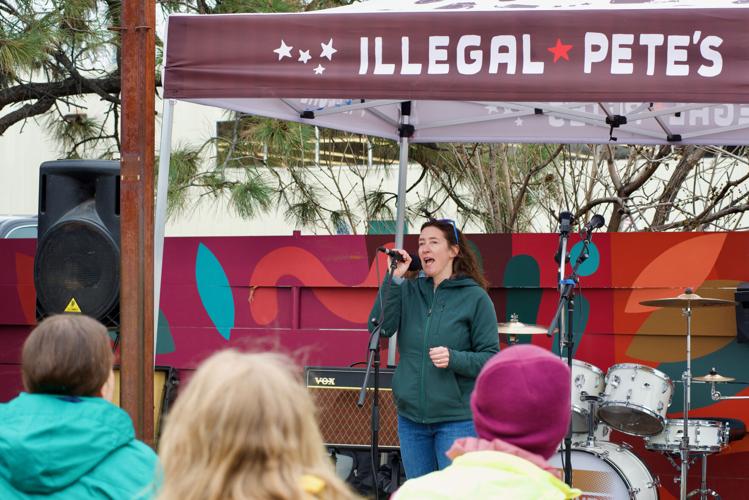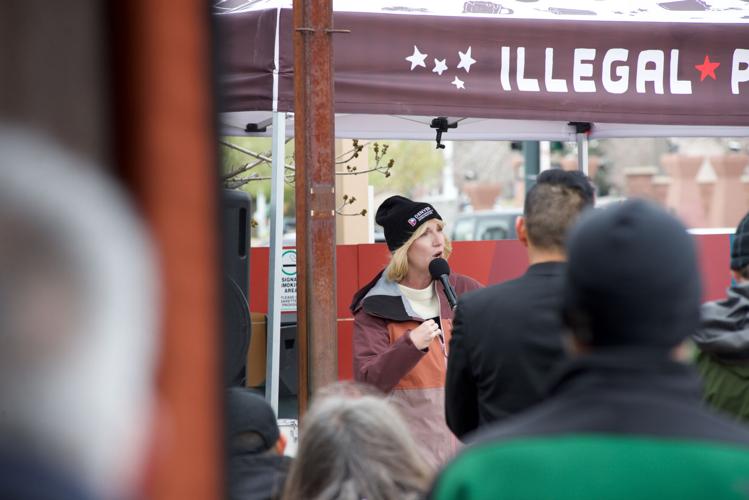Denver officially opens Broadway bike lanes
Despite heavy winds along the Front Range, bicycle enthusiasts gathered Saturday at Governor’s Park for the opening of new bike lanes along a 1.5 mile stretch of Broadway.
The project reduced four driving lanes with a transit line to three with a transit line, giving room for the bike lane.
The lanes are the flagship of the Broadway Multimodal Improvement Project, which also included bus stop improvements and art installations for pedestrians to the major corridor.
Curbside parking is still available, but the two-way bike lanes are protected from the street by concrete curbs. The city’s effort was in the works for roughly a decade, and work finally began in October 2022. Though the original plan was to finish the lanes in 2023, the grand opening didn’t occur until February.
Many businesses along the Broadway corridor let out a huge sigh of relief when the work finished, according to Luke Johnson, president of the Broadway Merchants Association. The completion of the lanes, he said, will hopefully increase foot traffic, which was stifled during construction.
“We had a lot of issues with construction, parking was deleted and that was a tough pill to swallow,” he said. “So, I think a lot of those concerns can be mitigated by people using the bike lanes and still shopping at the businesses, keeping sales up.”
Though earlier Denver Gazette reporting highlighted issues of open-air drug use on South Broadway, Johnson said he doesn’t think the bike lanes will contribute to an increase or decrease in those behaviors. He said the solution to those issues are bigger than the businesses on Broadway, largely agreeing with Denver Library officials, who called drug addiction a “societal issue.”
While happy to see construction completed, Johnson expresses worries that people may not use the lanes. If that happens, businesses that had already put up with parking reductions would be “upset,” he said, before calling the lanes a potentially mixed bag.
If nobody uses them, they’re a bust, but for now the biggest factor for businesses is the conclusion of construction, he said.
For residents like James Warren, who lives in the Villa Park neighborhood on the north end of Denver, the lanes are a vision into a world Denver could have.
“Broadway is a great example of people being wrong when they say nobody would bike here,” he said. “Well, nobody biked here because it’s the craziest road in town. But now you can point to it and say, ‘Look, people do bike here.”
He said the addition of concrete barriers made him feel very comfortable and safe riding down one of the busiest — and most dangerous — roads in Denver. While Warren appreciates the plastic and rubber installations that have become ubiquitous in other parts of town, he said he sees says the future lies in concrete and separation from traffic.
The addition of bike signals — traffic lights for bikes — is also a huge benefit to Heidi Newhart, the head of the mobility committee for the West Colfax registered neighborhood organization. Having the barriers and signals “legitimizes” bikes as a form of transit and reinforces the idea that they are actually part of traffic, she said.
District 7 Councilwoman Flor Alvidrez braved the elements and really enjoyed the community ride. She highlighted the importance of “protected” bike lanes for kids and brought along her eight and a half-year-old son, Alejandro, who loves cycling, she said.
“It’s very exciting and it’s a step,” she said. “My favorite part has been bringing my son because he loves to ride his bike, and now he will have another space to feel safe while doing it.”
Denver’s efforts to add bike lanes attracted controversy in other parts of the city.
Last year, residents surrounding Little Cheesman Park complained after the city installed a maze of lanes and colored zones painted into their streetscape, flanked by some 80 bollards — waist-high poles poking up from the pavement, some of them taking spaces away from the area’s already crowded parking.
A meeting organized by residents to discuss options drew a crowd and turned contentious as representatives of a cycling organization that had been notified arrived to support the new infrastructure.
City officials earlier said the overarching goal for the new bike lanes through core neighborhoods is safety.
Whether the approach will work remains to be seen. Last year, Denver tracked 83 traffic-related fatalities and 425 serious bodily injuries, according to the Vision Zero dashboard.
The city police tracked an increase in pedestrian crashes last year compared to the year before, a rise in deaths that occurred five years after Denver launched Vision Zero, a citywide effort to reduce traffic-related deaths to zero by 2023.
So far in 2024, 13 people have been killed.
Many fatalities happened on arterial roads like Broadway and Colfax Avenue. Which was the whole point of the Broadway project, according to Jill Locantore, the executive director of the Denver Streets Partnership.
“Today is a win not just for Broadway. This is a really important milestone in the evolution of our streets citywide,” she said. “This is the first real example we have of how an arterial street, where most of our traffic fatalities are happening, can evolve to be a truly multimodal main street that is safe for everybody.”










